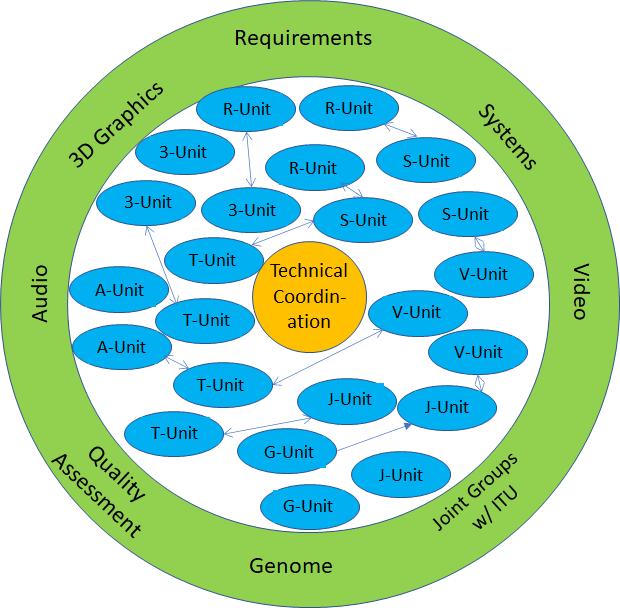MPEG started as a group tasked to develop a standard for interactive video on compact disc (CD). That was the great idea to make a standard that made sense. Telcos were not providing meaningful access to broadband. At most, you could get 64 kbit/s. Even today, after 30+ years of impetuous progress in compression, you don’t get much from a 64 kbit/s video. Therefore, for years and years, the videotelephone and videoconference business stagnated.
Developing a standard for a consumer-application like interactive video on CD was the deciding factor that made the difference with ITU-T standards: 18 months after its first meeting, MPEG, a group born haphazardly, had a membership of 100 and of 200 two years later. Far from being just concentrated on aspect of the audio-visual story, they were also working on audio coding, transport and multiplexing, hardware and software implementation complexity studies, quality assessment and more.
In The very first steps of MPEG, I explained how the first MPEG subgroup – Audio – was created in December 1988. What about the others? A full answer to this question would take many pages as you can see from the list of subgroups and chairs.
At the Stockholm meeting in July 1989, the second MPEG subgroup – Video – was established. Didier Le Gall (Bellcore and laterCCube), who had been managing the video matters for some time, was appointed as chair. Thomas Sikora (HHI, then Berlin University) took over from Didier when MPEG-4 was about to start.
At the Kurihama meeting in November 1989, when MPEG people were assessing the responses to the video Call for Proposals and producing the first Reference Model, new subgroups were established and chairs appointed.
Tsuneyoshi Hidaka (JVC) was appointed as chair of the Test group having developed and applied the testing methods leading an ad hoc group. After Tsuneyoshi resigned in 1995, the Test group was entrusted to a succession of chairs. Over the years, the nature of testing morphed from one big event on the occasion of responses to Calls for Proposals to an activity that extended regularly to all meetings.
Allen Simon (Intel) led the Systems group in charge of developing the multiplexing and transport layer. Allen’s tenure was brief and followed by Sandy MacInnis (IBM, 3DO and then Broadcom). Sandy led the development of the MPEG-1 and -2 Systems layer. The latter was awarded an Emmy. Jan van der Meer (Philips) led the group for a short time. The Systems group was then revived by the MPEG-4 project and led by Olivier Avaro. When Olivier left, Youngkwon Lim (Samsung) took over.
Colin Smith (Inmos, later acquired by ST Microelectronics) was the first to lead the VLSI group and soon replaced by Geoff Morrison (British Telecom) in the transition from a predominantly hardware-driven to a more software-driven design. He was followed by Paul Fellows (ST Microelectronics) and then by Marco Mattavelli (EPFL). My previous experience in standards committees had taught me a lesson: when issues become thorny, it is advisable to reformulate the issues in a new environment. That was a reason behind the creation of the VLSI group (later called Implementation Studies Group) and other groups.
Takuyo Kogure (Matsushita) led the Digital Storage Media (DSM) group. The reason for creating this group was because MPEG-1 was about interactivity with storage media but, for most participants, consumer electronics storage media were largely unknown. The group produced the Digital Storage Media Command and Control (DSM-CC) standard. The the group morphed into the Delivery Multimedia Integration Framework, established at the Stockholm meeting (July 1987) and chaired by Vahe Balabanian (Nortel) when MPEG-4 faced the need for a delivery agnostic interface (which, to some extent, part of DSM-CC already was).
At the first meeting after the kick-off of the MPEG-2 standard (Santa Clara, September 1990) the Requirements group was established under the leadership of Sakae Okubo. This was done for two reasons: the first to formally institute the process of identifying requirements from the different application domains of this cauldron of boiling magma called television, and the second to establish a collaboration with ITU.
At the London meeting (November 1992), when MPEG-1 was finally approved, the Applications and Operational Environments group was established under the chairmanship of Cliff Reader (Cypress Semiconductor and then Samsung). The group paved the way to the broad MPEG-4 project and was eventually split in Requirements, Systems and Synthetic Natural Hybrid Coding (SNHC) at the Munich meeting (January 1996). For Systems this was a rebirth after the glorious MPEG-1 and MPEG-2 years. The mandate given to the Systems chair Olivier Avaro (France Telecom and then Streamezzo) was to find a solution to the 3D interactivity dreams of the time. Olivier left MPEG and was replaced by Youngkwon Lim (Samsung). The mandate given to the SNHC chair Peter Doenges (Evans and Sutherland) was to develop standards for compression of Synthetic data. This was a tricky area because JTC 1 had their pet Subcommittee SC 24. By way of prudence, the group kept this anodyne name for years until the last chair Marius Preda (Institut Mines Télécom) made the bold proposal to call it 3D Graphics (which is what it had always been).
At the same Munich meeting the Liaison group was established under the chairmanship of Barry Haskell (Bell Labs), a decision prompted by the growing number of organisations with whom MPEG was communicating. When Barry retired, Jan Borman (IMEC) took over and was followed by Kate Grant (Nine Tiles).
The establishment of the Integration group, at a time when keeping track of all MPEG activities in an integrated fashion was becoming a challenge, looked like a good idea. The group was established at the Shanghai meeting (October 2002) and Jean-Claude Dufour (Telecom-ParisTech) led it for 9 meetings.
The MPEG-7 project is quite a special story. At the 4th MPEG meeting (Hannover, November-December 1988) the need to include “multimedia” in the picture was identified. So, I invited my friend Francis Kretz (CCETT) to present his views on the matter and the parallel Multimedia-Hypermedia Experts Group (MHEG) was established. At the Seoul meeting (November 1993), I proposed to the MPEG parent body SC 29 to study the issue of describing the large amount of content that digital technologies would make possible. An ad hoc group was established but one year later there was no report. Another year was granted, but still no result.
I took this as a signal that MPEG could do it and so I did. At the Vancouver meeting (July 1999) the need for Multimedia Description Schemes (MDS) as a unifying technology for MPEG-7 was identified and a new MDS group was created. The initial chair was Philippe Sabatier (Universidad Politécnica de Catalunya). Subsequently, the group was put in charge of most MPEG-21 technologies.
At this point, the reader will probably conclude that MPEG was just another organisation with a hierarchical structure. Such a conclusion would be a mistake. The figure below describes the amount of far from hierarchical interaction that took place in MPEG, as explained in MPEG: vision, execution, results and a conclusion, .

The subgroups are represented in the circle surrounding “units” emanating from subgroups indicated by first letter of their names. Units were temporary or stable entities within the subgroups who got together (indicated by the arrows) across organisational boundaries as orchestrated by the subgroup chairs meeting as “Technical Coordination”.
This is a very summary roundup of the – quite a few – MPEG subgroups established in the 32 years of MPEG life. That was a great positive personal experience.
For those interested, there is much more to learn: the book Even the stars die – The history of MPEG and how it made digital media happen


